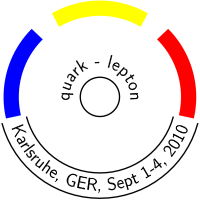Speaker
Mr
John Alison
(University of Pennsylvania)
Description
ATLAS is a multipurpose experiment that records the products of the LHC proton‐proton
collisions. In order to reconstruct the trajectories of charged particles, ATLAS is equipped
with an inner tracking system built on silicon planar sensors (pixel and microstrips) plus
drift‐tube based detectors, all embedded in a 2 T solenoidal field.
In order to achieve its scientific goals, the alignment of the ATLAS tracking system
requires the accurate determination of its almost 36000 degrees of freedom (DoF). Thus the
physics goals of the experiment demand an alignment precision of the silicon sensors below
10 micrometers.
The implementation of the track based alignment within the ATLAS software framework
unifies different alignment approaches and allows the alignment of all tracking subsystems
together. The use of the assembly survey data as well as the primary vertex and beam spot
constraints have been implemented in the alignment software. As alignment algorithms are
based on minimization of the track‐hit residuals, one needs to solve a linear system with a
large number of DoF, which poses a numerical challenge. The alignment jobs can be executed
at the CERN Analysis Facility or using the GRID infrastructure. The event processing is run in
parallel in many jobs. The output matrices from all parallel jobs are added in a single one
before solving.
We will present the results of the alignment of the ATLAS detector using many millions of
real data high pT tracks recorded from the 7 TeV LHC collisions of the 2010 run. The
alignment validation is performed with measurements of the alignment observables as well
as many other physics observables, notably resonance invariant masses (in the following
channels: K0s→π+π‐, J/ψ→μ+μ‐, and Z→μ+μ‐), the E/p ratio for electrons, the decay length of
long lived particles, plus the impressive results on material studies from γ conversions and
hadronic interactions. The results of the alignment with real data reveal that the current
precision of the alignment constants is about 10 microns.
Authors
Dr
Daniel Kollar
(CERN)
Mr
John Alison
(University of Pennsylvania)
Dr
Salvador Marti I Garcia
(IFIC-Valencia)
